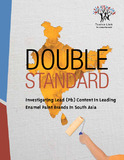Please use this identifier to cite or link to this item:
https://hdl.handle.net/20.500.14356/699| Title: | Double standard: Investigated lead (pb) content in leading enamel paint brands in South Asia |
| Authors: | Toxics Link, New Delhi Environment and Social Development Organization-ESDO, Bangladesh Center for Public Health and Environmental Development (CEPHED), Nepal |
| Issue Date: | 2011 |
| Publisher: | Toxics Link |
| Keywords: | Double standard: Investigated lead (pb) content in leading enamel paint brands in South Asia |
| Abstract: | Executive Summary: Lead (Pb) compounds have been historically used by paint manufacturers. A number of properties of lead make it commercially attractive for its use in paints. It has colour vibrance and the ability to hold pigments well. It helps paints stand up well to outside weather elements, impart high degree of corrosion resistance and also reduces drying time. In the form of lead carbonate and lead oxides, it has excellent adhesion, drying, and covering abilities. Economically, it is relatively inexpensive. However, lead based decorative paints (and other products such as gasoline for that matter) have posed several health problems in the developed world. Lead based paints have long been proven to be associated with elevated blood lead levels in children causing subsequent lead poisoning. Scientific evidences have established that children are the most vulnerable population and can be seriously impacted even at very low levels of blood lead. While the toxicity of lead becoming apparent, several western countries have enacted ban or imposed restriction on the use of lead in interior paints (Markowitz, 2000).Countries like the US and China have restricted its use to 90 ppm in decorative paints. Also, the sixth session of the Intergovernmental Forum on Chemical Safety (IFCS), held from 15-19 September 2008 in Dakar, Senegal, adopted a unanimous resolution to eliminate lead from paints worldwide. Whereas The Blacksmith Institute’s World´s Worst Pollution Problems Report 2010indicts lead (Pb) as the deadliest of top six toxic threats globally (and estimates that 18-22 million people worldwide are impacted currently) and the World Health Organisation (WHO) reviewing the current science on lead toxicity, it is now widely accepted that there is ‘no safe blood lead level’ in humans. Sans WHO’s efforts, there has been a concerted global drive against the use of lead in products that eventually become sources of lead exposure and poisoning. Toxics Link has been actively campaigning in the South Asia region on the issue of chemicals safety through a chain of regional partners. Our interest in South Asia lies primarily in the fact that we share some common concerns and the proximity of our borders makes us vulnerable to a spillover of toxic effects. Asia is an ever-growing market for paints. Various studies suggest that Asia will eventually emerge as the largest consumer of paints, keeping in mind the growth rate over the years. The coating solution sector has been growing at an average rate of about 10% in recent years. Overall, decorative paint accounts for 60-70% total paint market in the region. The players in the organized sector dominate the paint business and their market share is between 60-90% in different countries belonging to the region. Multinational brands such as Asian Paints, Berger, Nerolac, Jenson and Nicholson and ICI are the major players and happen to have overlapping interests in the paint market in the region. The major worry in the region is that the countries have either voluntary standards or no standards for lead in decorative paints. While India has a voluntary ECO-Mark standard for lead (1000ppm) 7in Sri Lanka it is 600ppm. There is no regulatory mechanism to restrict the lead concentration in paints in Nepal and Bangladesh. To summarize the existing regulatory framework in the region is such that manufacturers are not mandated to limit lead in their products. While claims have been made by paint majors regarding production and sale of lead-free decorative paints in the region, many independent studies suggest that several of them continue to have lead in excessive quantities. Further, in our recent engagements on the issue we found that the paint manufacturers tend to take advantage of the non-existent lead in paint standards in countries like Nepal and Bangladesh where the lead concentration in leading paint brands were found to be alarmingly high. Looking at the closely knit, overlapping and integrated paint business, growing public health concerns over the use of lead in paint in the region and the existing non-enforceable regulatory mechanism, we decided to take up this study of common paint brands to affirm if the acclaimed and responsible multinationals adhere to comparable standards across countries of South Asia region. In short, we wanted to ascertain whether the leading paint manufacturers follow ‘double standard’ in the region. |
| URI: | http://103.69.126.140:8080/handle/20.500.14356/699 |
| Appears in Collections: | Post Graduate Grant (PG) Reports |
Files in This Item:
| File | Description | Size | Format | |
|---|---|---|---|---|
| 679_Double_Standard-_Final_Print_Version.pdf | Full Report. Download | 3.08 MB | Adobe PDF |  View/Open |
Items in DSpace are protected by copyright, with all rights reserved, unless otherwise indicated.
